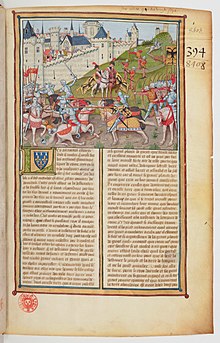
Back معركة نينوى Arabic نینوا دؤیوشو (۶۲۷) AZB Битка при Ниневия Bulgarian নিনেভের যুদ্ধ (৬২৭) Bengali/Bangla Batalla de Nínive Catalan Bitva u Ninive Czech Schlacht bei Ninive German Μάχη της Νινευή Greek Batalla de Nínive Spanish نبرد نینوا (۶۲۷ میلادی) Persian
| Battle of Nineveh | |||||||
|---|---|---|---|---|---|---|---|
| Part of the Byzantine–Sasanian War of 602–628 | |||||||
 Anachronistic depiction of the Battle of Nineveh in a late 15th century illuminated French manuscript (by Robinet Testard) | |||||||
| |||||||
| Belligerents | |||||||
| Byzantine Empire | Sasanian Empire | ||||||
| Commanders and leaders | |||||||
| Heraclius |
Rahzadh † Vahram-Arshusha V (POW) | ||||||
| Strength | |||||||
|
25,000–50,000 Byzantines[1] 40,000 Göktürks (deserted) | 12,000 Sasanians[2] | ||||||
| Casualties and losses | |||||||
| 50 killed[3] | 6,000[2] to 12,000 killed[4] | ||||||
Location within West and Central Asia | |||||||
The Battle of Nineveh was the climactic battle of the Byzantine–Sasanian War of 602–628.
In mid-September 627, Heraclius invaded Sasanian Mesopotamia in a surprising, risky winter campaign. Khosrow II appointed Rhahzadh as the commander of an army to confront him. Heraclius' Göktürk allies quickly deserted, while Rhahzadh's reinforcements did not arrive in time. In the ensuing battle, Rhahzadh was slain and the remaining Sasanian forces retreated.
The Byzantine victory later resulted in civil war in Persia, and for a period of time restored the (Eastern) Roman Empire to its ancient boundaries in the Middle East. The Sasanian civil war significantly weakened the Sasanian Empire, contributing to the Muslim conquest of Persia.
- ^ Kaegi 2003, pp. 158–159
- ^ a b Kaegi 2003, p. 167
- ^ Greatrex 1991, p. 214.
- ^ Ostrogorsky 2011, p. 153.

